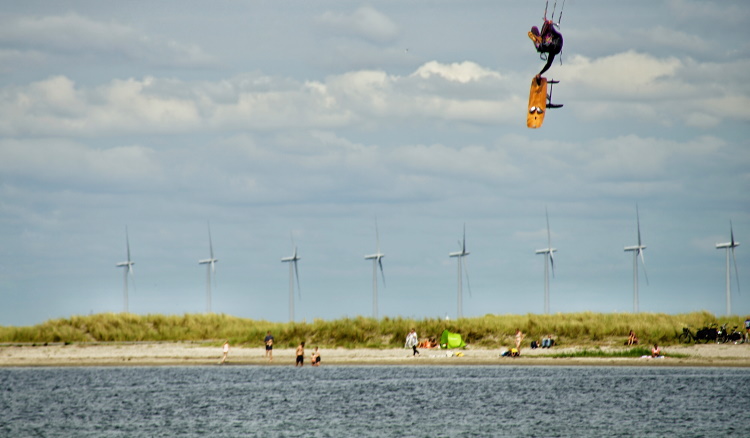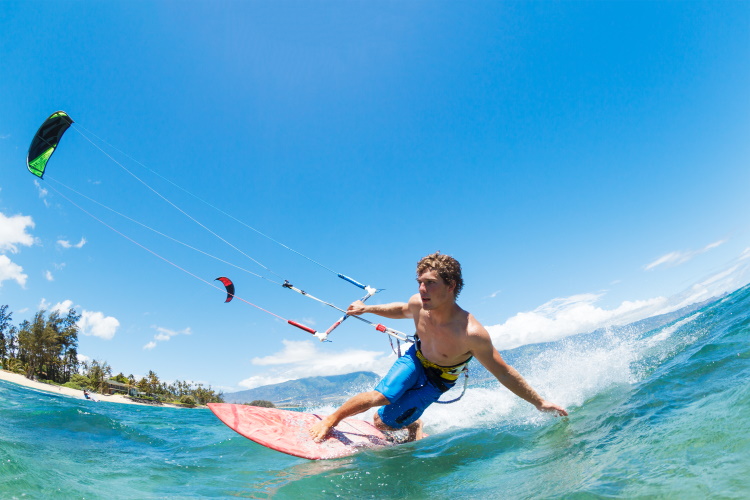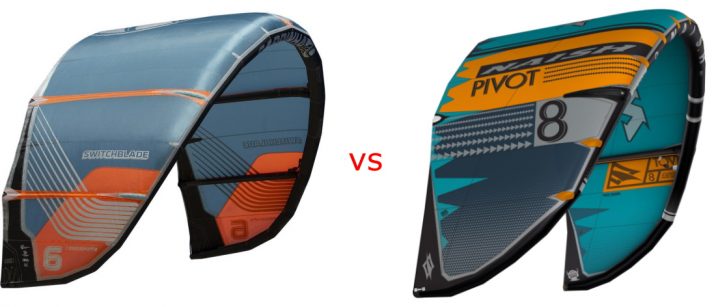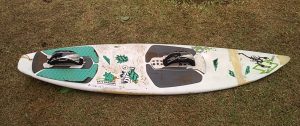The Naish Pivot and Cabrinha Switchblade are two leading all-round kites primarily marketed as freeride kites and suitable for both beginners and advanced riders.
If you want a kite that can be used in both waves and for freeriding, the Naish Pivot is the right choice. If you prefer a kite that offers stability and is purely for freeride or big air then the switchblade may very well be your guy.
The Pivot is a faster turning kite with lighter bar pressure and better drift. The Switchblade, on the other hand, has more grunt. Larger riders may feel more comfortable on the Switchblade due to its stronger pull.
| Cabrinha Switchblade | Naish Pivot | |
|---|---|---|
| Construction | Strong and durable kite, improved in 2020 | The strongest canopy in the market, surf-proof |
| Power & wind range | Grunty, high bar pressure, great bottom-end, great depower | Also powerful but less grunty, slightly less bottom and high-end, lighter bar pressure |
| Stability & turns | Slower turns, highly stable | Fast turns, great drift |
| Jumping | Highest jumps, lots of power, good hangtime | Easy jumping and landing, long hangtime |
| Relaunch | Great relaunch, easy for beginners | Great relaunch, better in light wind due to lighter build |
| Riding styles | Best for freeride, big air, and freestyle tricks | Versatile: freeride, big air, wave riding, foiling |
The decision ultimately comes down to whether you prefer the fast turns of the Pivot or the stability of the Switchblade and what type of kiter you are.
Check out the Cabrinha Switchblade and Naish Pivot on Green Hat
Table of Contents
Switchblade vs Pivot: kite construction

The Switchblade is a 5-strut kite compared to the 3 struts of the Pivot. This makes the Pivot a noticeably lighter kite – the 9m Pivot weighs in at 2.86 kg vs 3.31kg for the Switchblade.
Both the Naish Pivot and the Cabrinha Switchblade have high-quality construction. Naish models have exclusive use of the Quad-tex ripstop fabric, seen as the strongest canopy in the market today. In some tests, it was proven to be 30% stronger than other ripstop fabrics.
The quad-tex fabric has been around for a number of years but Naish has made some changes to the 2020 version by adding an additional seam to distribute the tension across the kite.
The Cabrinha Switchblade has introduced a new durable canopy in 2020 called Nano ripstop which doubles the strength while maintaining the same weight.
Cabrinha has also plasma treated its canopies which creates a longer-lasting coating and separates itself from competitors in the lifespan of the kite’s quality. Both kites have invested heavily in kite quality for 2020.
While Naish has been at the top of this part of the kite construction game for many years, Cabrinha has now made some smart investments.
Switchblade vs Pivot: power & wind range
The Naish Pivot has always offered a large wind range thanks to a strong depower system. The Pivot was designed to capture a large wind range to suit riders who use it in Big Air competitions and want to ride the biggest kite they can in the strongest wind.
The Switchblade also has a broad wind range – riders without a big quiver get a lot of use out of a single kite. The Cabrinha 8m is typically be enough for a 75kg rider from 15 knots to 30 knots while the sweet spot would be from 18 knots to 27knots.
The Naish pivot 8m typically works well for a 75kg (165 lb) rider from 17 knots to 28 knots with the sweet spot being 20 knots to 25 knots. Overall, the Switchblade has better bottom range compared to the Pivot, while the top end is a closer call.
The Switchblade is a gruntier kite and generates greater pull. The Pivot offers a smoother ride and lower bar pressure than the switchblade. The Switchblade has consistently higher bar pressure, a deliberate choice to give a greater feel of the kite.
For a lighter bar pressure Cabrinha kite, you can check out the Moto or the Drifter.
The Naish Pivot works well for staying upwind, making it a suitable kite for all levels of rider. The switchblade is also a fantastic upwind kite, it always feels a little forward of the center of the wind window, which makes riding upwind easier.
See pricing for the Cabrinha Switchblade and the Naish Pivot on Green Hat
Switchblade vs Pivot: stability & turns

The Naish Pivot gets its name from its ability to turn sharply. The standout feature of the kite is the quick turn it offers, which is why many top riders choose it for competitions. Kevin Langree won KOTA in 2018 and 2019 with a Naish Pivot.
The Pivot’s turning ability is due to the profile of the kite with flat tips that create minimal drag. Naish has altered the tips slightly from previous editions which eliminates the irritating flutter when turning the kite aggressively.
Older editions of the Switchblade were much slower turning. Changes in the 2020 model made it noticeably faster, but still not as reactive as the Pivot.
When it comes to quick turning, few kites can outperform the Naish Pivot.
Rider feedback
The Cabrinha Switchblade also has a track record of winning awards at competition. This kite is suitable for both pros and beginners due to the stability it offers.
The Switchblade owes its stability to the five strut approach and the additional paneling in the main areas to reinforce the kite and provide more stability to the rider.
The Switchblade is the clear winner for stability, one of the reasons for it being one of the most popular kite models out there today.
Switchblade vs Pivot: jumps
Both kites offer excellent attributes in the air, as you would expect from leading freeride kite models. The pulling power of the switchblade leads to high jumps and long hangtimes, while the pivot is a kite that makes jumping feel easy.
The easy control that the Pivot offers and forgiving design of the kite means that it is easy to jump high. However the Switchblade has greater power and when used correctly can deliver the highest jumps
The easy turning of the Naish does allow you to quickly correct any moves to ensure a good landing at the last moment. While the Switchblade jumps higher the Pivot has better hang time.
Switchblade vs Pivot: relaunch
Both kites offer excellent relaunch, again something that’s expected of freeride kites today. The Naish Pivot uses an advanced draining system to get rid of any excess water on the inside of the kite quickly and enable an easy relaunch.
The Switchblade uses an intelligent arc system that means the kite flies with one arc, and when floating on the water, opens slightly to allow for a quick relaunch.
In light wind conditions, both kites offer accomplished relaunch but the Pivot will perform better due its lighter build.
See the Cabrinha Switchblade and the Naish Pivot on Green Hat
Switchblade vs Pivot: riding styles
Both kites are positioned as freeride kites in the market and excel in this area, but that is where the similarity ends.
The Naish Pivot is a much more versatile kite and can be used for freeriding and big air as well as waves. The Switchblade is great for freestyle tricks and big air but noticeably lacks the same ability when wave riding due to the much slower turning.
The speed that the Naish pivot has makes it excel in the waves, and when you lose control it noticeably drifts well. The switchblade is a little slower to react and doesn’t offer the same security when it goes in the waves.
If experimenting with foiling both kites will perform reasonably well. The 5-strut Switchblade will feel heavier in light winds and feel more sluggish compared to the Pivot. The fast turning nature of the Pivot will also make it more suitable for foiling.
For riders who want one kite to do everything, the Pivot is the clear front runner while for those kiters who prefer to stick to freeriding, the Switchblade performs great.
Switchblade vs Pivot: inflate system
Naish has redesigned the inflate systems on all kites. The previous octopus system made removing the bladder difficult and the new changes have addressed this. The new system is far more simplified with one valve used for deflation and inflation.
This means that you no longer have to deflate individual struts. The push-button valve and twist lock system make inflating and deflating easy, although it may take a few sessions before you get used to the difference.
The Switchblade uses the Sprint system which is a large valve for inflating and deflating the kite quickly. There are no adaptors required allowing inflation directly from the standard pump attachment.
Each strut can be locked off after deflation to ensure the kite remains rigid, and that if a strut has an issue, the rest of the kite remains inflated.
Check out the Cabrinha Switchblade and the Naish Pivot on Green Hat
Switchblade vs Pivot: control bar
The Switchblade comes with a choice of two bars – the Trimlight and the Recoil. The key difference is that the Recoil uses a belt system that is kept in place with springs. The Trimlight is a simpler set up with a rope and cleat to depower the kite.
Overall the Trimlight is a cleaner, simpler option while the Recoil is a more engineered solution that is particularly suitable to those with shorter arms.
The Pivot comes with the Torque bar with a single depower system that you can choose to set either above or below the bar. Both options of the Torque bar use a standard rope and cleat system.
While the Naish bar looks great and has the above/below depower option, the Cabrinha can have a completely different depower system for those who don’t like the cleat.
Both the Cabrinha and the Naish bars come with a low V as standard which makes it easier to self land and solve any tangles.
The Torque bar and lines follow the standard color palette with red on the left and blue on the right, strong and clear colors. The Cabrinha bar goes with black on the right and white on the left with all grey lines, losing to the Pivot in terms of clarity and safety.
On the Pivot’s bar, the center lines end in lark heads while the outside lines end in knots. Meanwhile, the Cabrinha center lines end in knots while the outside lines end in lark head loops.
Final words
Two excellent kites that meet expectations in all areas they claim to with both offering high jumps and large hangtime. The Naish Pivot is a faster turning and more versatile kite suited to all forms of kitesurfing.
The Switchblade still offers a lot of versatility and can be used in a wide range of areas but will not perform as well as the Pivot outside of Freeriding. The Switchblade is a kite that leads in stability and packs a strong punch.



